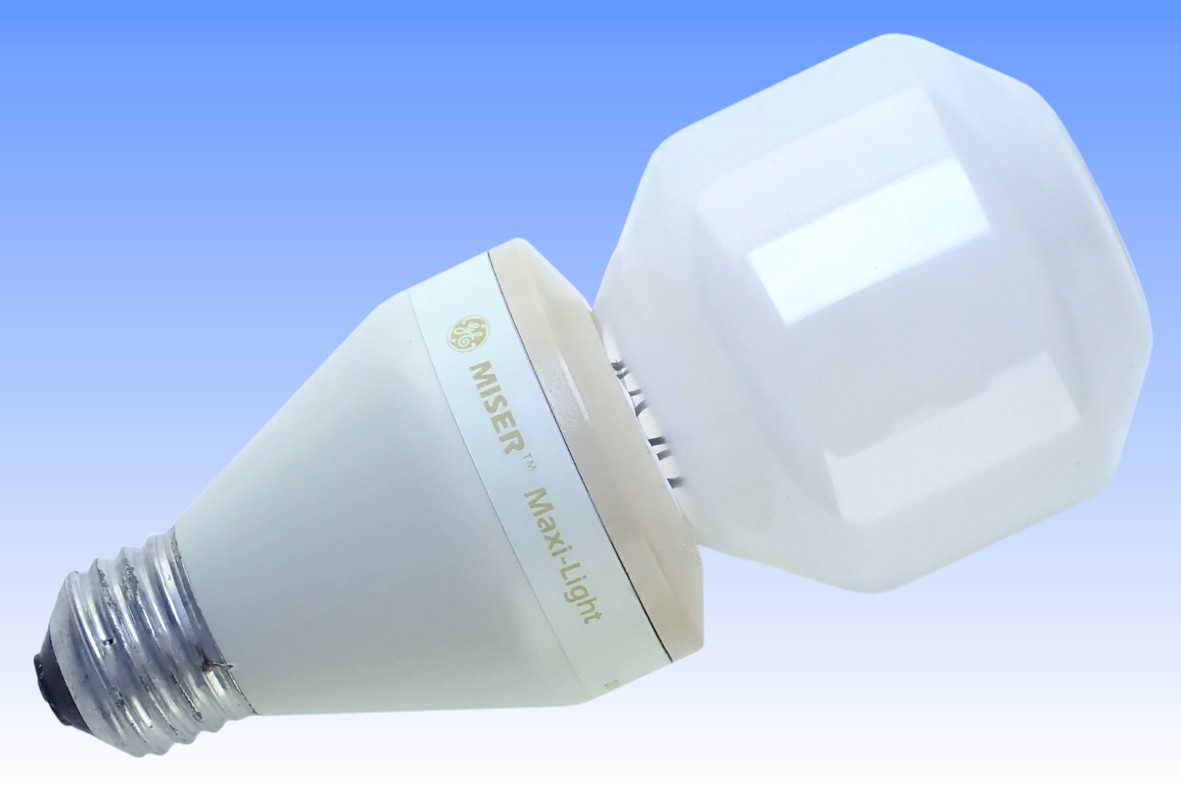
|
GE Halarc Electronic - Miser Maxi-Light |

At the heart of the lamp is a 32-watt sodium-scandium arc tube. To attain a warm colour light of 3200K for domestic use, it is operated on DC with the anode uppermost so as to draw sodium ions up into the arc stream. A quartz shroud helps to minimise sodium loss and keep colour stable during life. An incandescent filament is also included in the outer bulb. This provides instant light, even after a hot-restart while the arc tube is cooling, and helps miniaturise the electronic ballast by reducing the size of magnetic parts. The assembly is mounted on an 8-pin glass wafer stem, and sealed into a soft glass bulb with argon-nitrogen fill, plus a diffuse coating to mix the light from the filament and arc.
By the time GE completed development the energy crisis was over, and the competing Philips' SL lamp with compact fluorescent technology just beat it to the market. That overcame many of the drawbacks of compact metal halide technology, namely no colour instabilities, a pronounced flicker, restriction to vertical base down use, and the very high sale price. Despite millions of dollars of investment, GE's lamp was not popular and was withdrawn by 1984. It's arc tube however lives on in the Halarc 32 watt lamp.




| Manufacturer: | General Electric Co. (USA) | |
| Lamp Power: | 55 Watts | |
| Lamp Current: | 0.46 Amps | |
| Lamp Voltage: | 110-125 Volts | |
| Cap Type: | E26s/25 | Aluminium + vitrite |
| Bulb Type: | TB-60 | TB-19 in eighths/inch |
| Bulb Finish: | Diffuse | Soda-lime glass |
| Electrodes: | Asymmetric Tungsten | |
| Arc Length: | 5mm | 0.197 inches |
| Atmosphere: | Inner: Hg, NaI, ScI3 | Ar | Outer: Argon-Nitrogen |
| Luminous Flux: | 2,250 lm lm (@ 100 hrs) | |
| Luminous Efficacy: | 40.9 lm/W (@ 100 hrs) | |
| Colour Temperature & CRI: | CCT: 3200K | CRI: Ra 65 |
| Chromaticity Co-ordinates: | CCx: 0.421 | CCy: 0.392 |
| Rated Lifetime: | 5,000 hours | 50% survival++ |
| Warm-up & Re-strike Time: | 1 minute | 15 minutes |
| Burning Position: | Vertical Base Down only | |
| Overall Length: | 145 mm | 53/4 inches |
| Light Centre Length: | ||
| Factory: | Edison Park, Twinsburg OH | U.S.A. |
| Date of Manufacture: | c.1981-1983 | |
| Original Value: | US $15.00 (1981) | |
